Poor old George Megalogenis must have whiplash. In his 2012 hubris-dripping treatise The Australian Moment, he described how:
There’s no better place to be during economic turbulence than Australia. Brilliant in a bust, we’ve learnt to use our brains in a boom. Although the Great Recession continues to rumble around the globe, we successfully negotiated the Asian financial crisis, the dotcom tech wreck and the GFC. Despite a lingering inability to acknowledge our achievements at home, the rest of the world now asks: How did we get it right? This is the page-turning story of our nation’s remarkable transformation since the ’70s. One of our most respected journalists, George Megalogenis, traces the key economic reforms and brilliant moments of collective instinct that opened our society to the immigration of capital, ideas and people to just the right degree…
MB treated the palava with the contempt it deserved at the time.
In March this year, Megalogenis performed a 180-turn penning a Quarterly Essay panicking about the state of the Australian economy [my emphasis]:
In this urgent essay, George Megalogenis argues that Australia risks becoming globalisation’s next and most unnecessary victim. The next shock, whenever it comes, will find us with our economic guard down, and a political system that has shredded its authority.
Megalogenis outlines the challenge for Malcolm Turnbull and his government. Our tax system is unfair and we have failed to invest in infrastructure and education. Both sides of politics are clinging defensively to an old model because it tells them a reassuring story of Australian success. But that model has been exhausted by capitalism’s extended crisis and the end of the mining boom. Trusting to the market has left us with gridlocked cities, growing inequality and a corporate sector that feels no obligation to pay tax. It is time to redraw the line between market and state.
Balancing Act is a passionate look at the politics of change and renewal, and a bold call for active government. It took World War II to provide the energy and focus for the reconstruction that laid the foundation for modern Australia.
Will it take another crisis to prompt a new reconstruction?
Now Megalogenis has flip-flopped again, penning an opinion piece in the New York Times trumpeting that Australia’s high immigration intake has powered Australia’s economic surge:
If you were designing a nation from scratch, it would look something like Australia. A Eurasian people, boring politicians, and an economy that virtually runs itself.
Australia, uniquely, has avoided every major shock of modern globalization…
While other wealthy nations struggle to define their purpose, Australia has unlocked the secret to its next wave of prosperity. The key is the very thing that intimidates the United States, Britain and most of Europe: large-scale immigration.
Led by students from India and young professionals from China, new arrivals have managed to extend Australia’s winning streak for longer than any policy maker imagined… It has been 25 years since the last recession in Australia…
Since 2001, governments have largely let the market decide whom to bring into the country.
They did this by declaring a preference for skilled immigration over family reunion when granting permanent settlement…
Both doors, for permanent and temporary immigrants, remained open throughout the financial crisis… The economist Bob Gregory calculates that almost all of the additional full-time jobs created since 2008 have gone to overseas-born workers…
The surge in immigration has allowed Australia to continue to climb the income ladder when most other rich nations have been losing ground. In 2001, Australia was the 15th largest economy in the world. Today it is 13th…
The catch has been that national and state governments were too slow to expand the infrastructure to cater to the growing population… The property market is also inflated, and it may yet bring down the entire economy.
Nevertheless, these are problems of growth that most rich nations would kill for…
Righto George. So as you yourself admit, Australia has “failed to invest in infrastructure” and is suffering from “gridlocked cities”, a property market that is so “inflated [that] it may yet bring down the entire economy“ as well as “growing inequality”. Moreover, “almost all of the additional full-time jobs created since 2008 have gone to overseas-born workers”. Hardly sounds like existing residents have gained higher living standards from strong immigration, does it?
While it is true that Australia’s world-beating population growth has boosted overall economic growth (more inputs equals more outputs), the data suggests that it has made individual living standards worse.
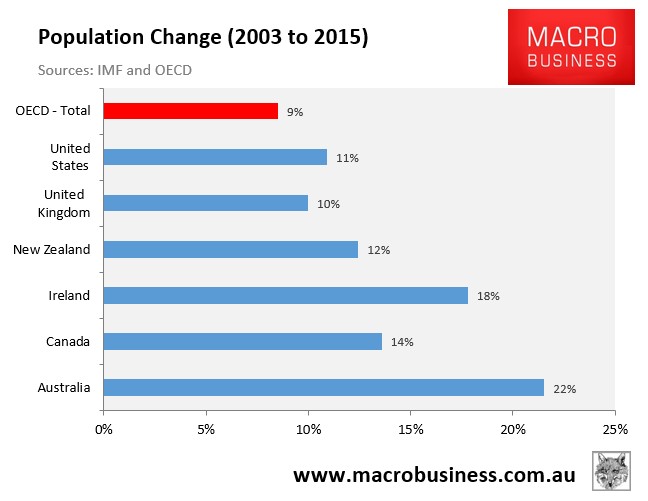
As shown in the next chart, GDP per capita growth has plummeted over the past 12 years as population growth surged. In fact, the 10-year annualised rate of growth has fallen to levels not seen since the early-1980s and early-1990s recessions:
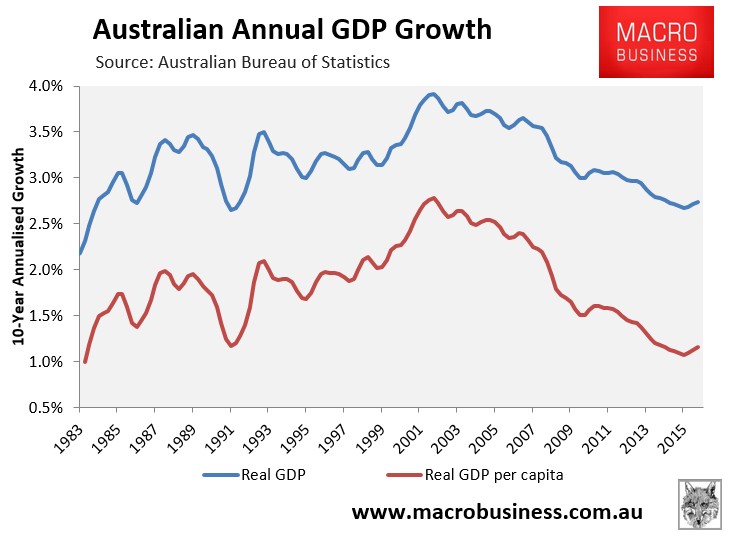
Since the immigration flood gates were jammed open in 2003, Australia’s per capita GDP and disposable income have also grown at an anaemic rate compared to the previous corresponding 12-year periods (see below charts).
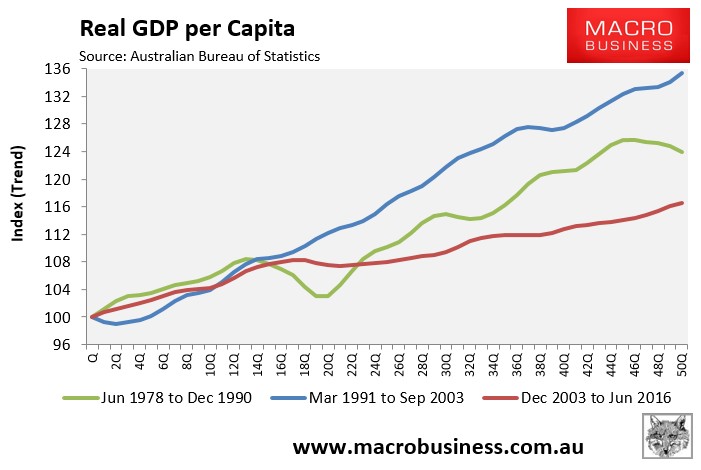
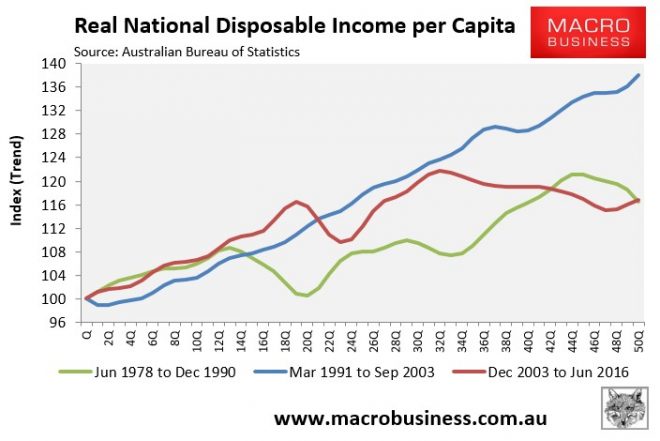
And this comes despite growth in the terms-of-trade being most favourable across the most recent 12-year period (see next chart).
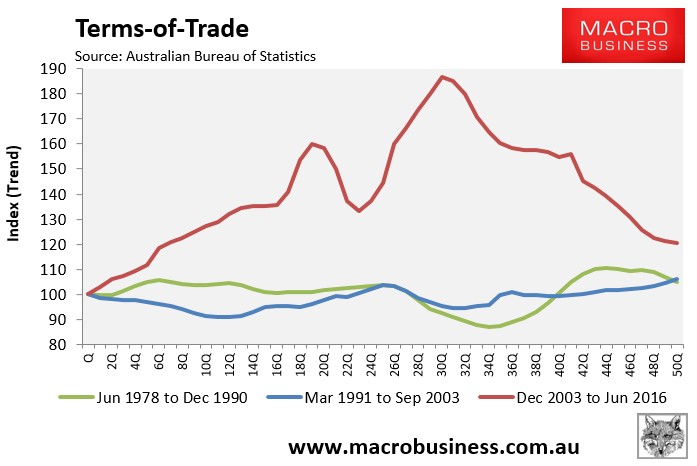
The Productivity Commission’s major study on the Economic Impacts of Migration and Population Growth also found that the benefits from increased skilled immigration likely flow to the migrants themselves, as well as to the owners of capital. However, “the incomes of existing resident workers grow more slowly than would otherwise be the case”. In other words, ordinary Australians are likely to be made worse-off through high skilled immigration.
When viewed alongside qualitative measures like traffic congestion and housing affordability, which have clearly worsened across Australia as the population has exploded, there is a strong case to be made that Australia’s world-beating immigration program is very likely lowering individual living standards.
There is also no statistically significant relationship between the growth in the population and per capita real GDP across OECD member nations:
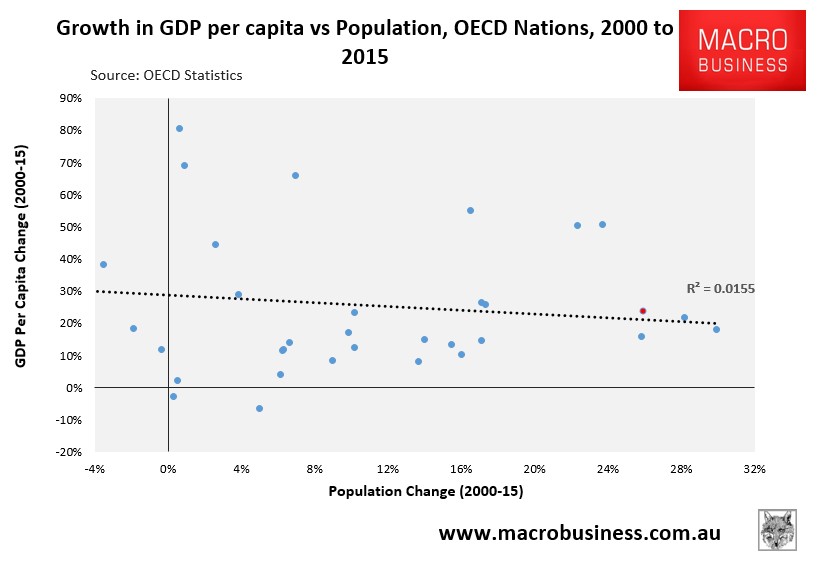
Nor any statistically significant relationship between population growth and productivity growth across OECD nations:
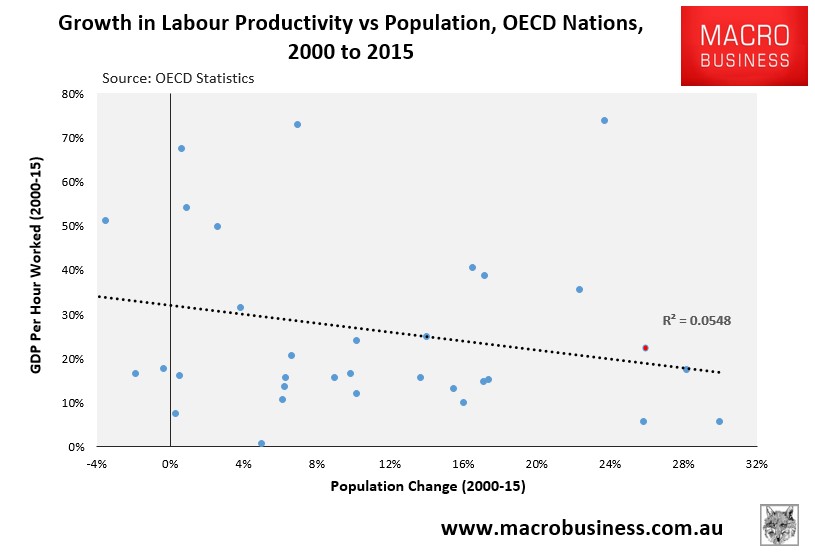
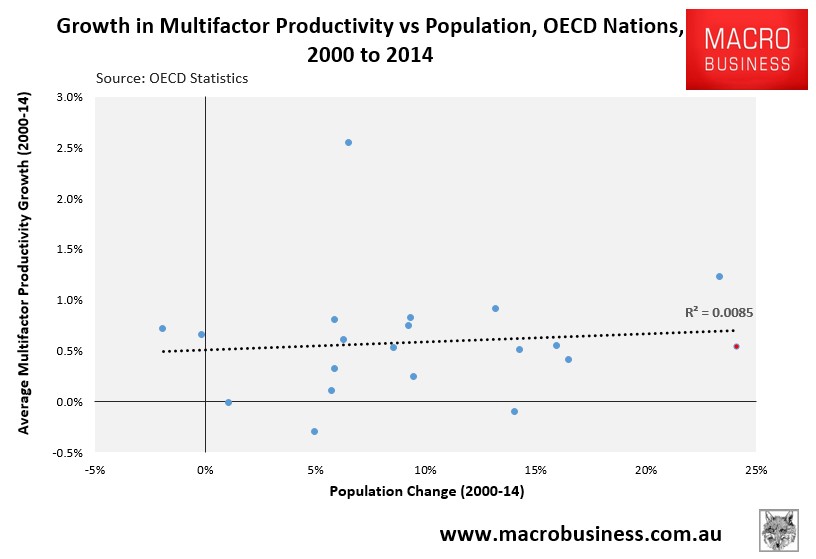
No George, the broad macroeconomic data – both domestic and international – does not support your assertion that high immigration has driven Australia’s economic success or increased living standards. In fact, given the significant qualitative costs – for example, the degradation of the environment, the depreciation of natural resources and decline in individuals’ quality of life – there is a strong case to dial Australia’s immigration intake back to sensible and sustainable levels.

